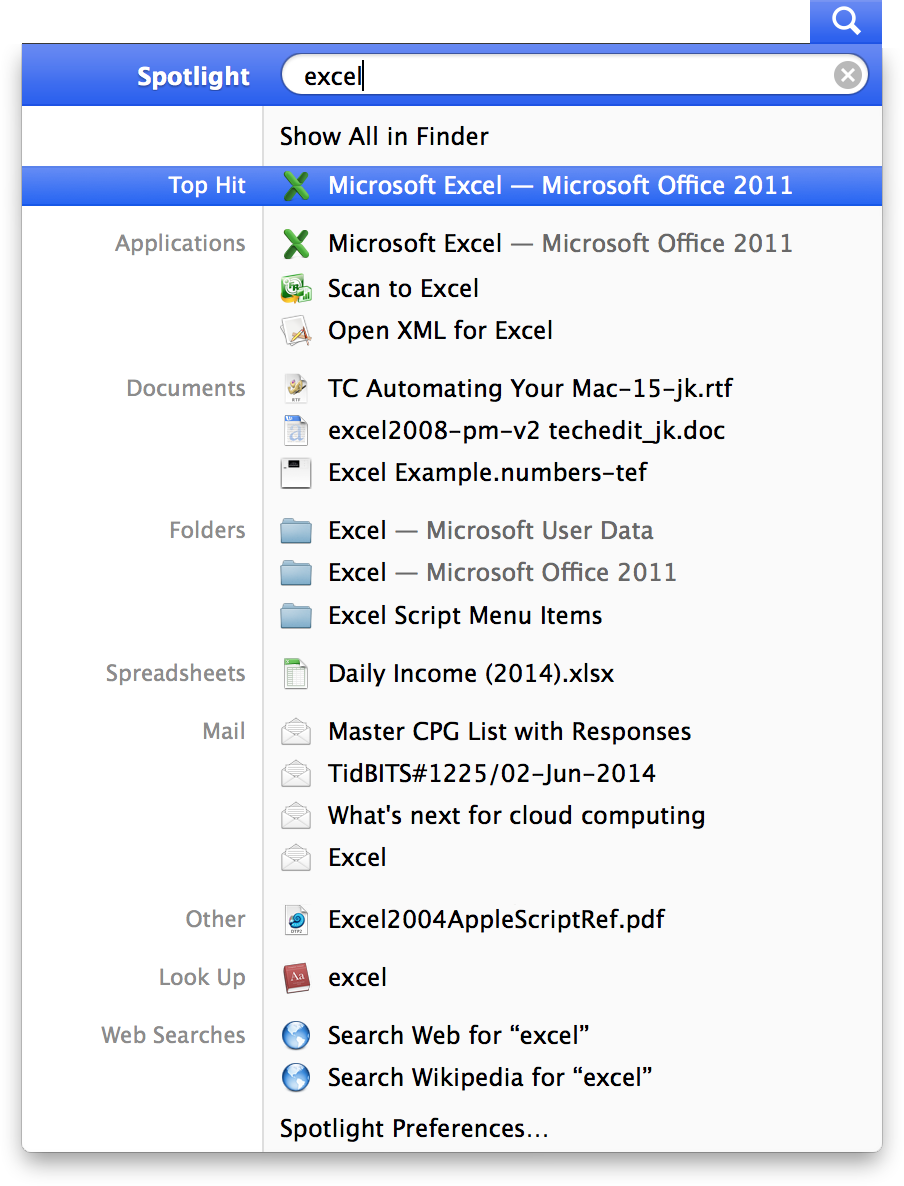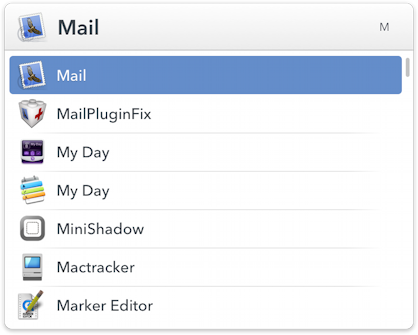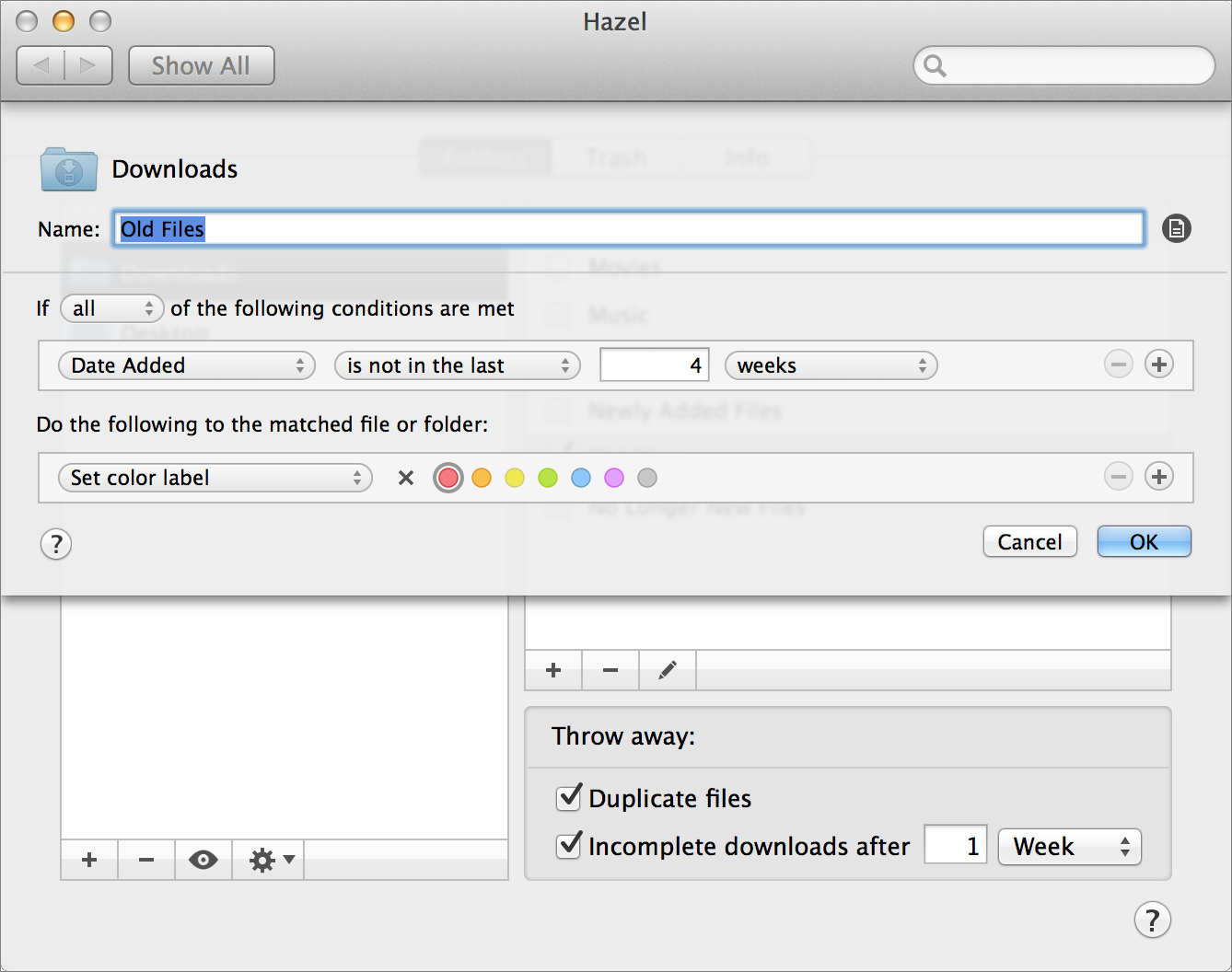Automate the Finder
The Finder is a special app that runs all the time and lets you navigate all the files, folders, and apps on your Mac. You use the Finder to organize, tag, and locate files; connect to other devices on your network; mount and unmount servers and external drives; and perform numerous other activities that involve files, folders, and volumes.
The Finder is also the main place people go to open apps that don’t appear in the Dock. When you want to launch an application, you might open a Finder window, click Applications in the sidebar, scroll to the app you want, and double-click it. Similarly, if you want to open a document in its default app, you might dig through any number of nested folders in the Finder and then double-click that document.
Since you use the Finder so much, it offers prime opportunities for automation. For example, it’s possible to launch apps and open documents without clicking and scrolling through any windows. In a second or less, while keeping both hands on the keyboard, you can open an app or document without even knowing where it’s located.
In this chapter, I discuss how to get started automating the Finder using OS X’s built-in Spotlight tool, and then I move on to more powerful third-party utilities that let you do even more.
Use the Spotlight Menu as a Launcher
You probably know about the system-wide Spotlight  menu on the right side of your menu bar. Click the magnifying glass icon and start typing; OS X lists files, folders, and other items on your Mac that match your search characters (Figure 14).
menu on the right side of your menu bar. Click the magnifying glass icon and start typing; OS X lists files, folders, and other items on your Mac that match your search characters (Figure 14).

Figure 14: Type in the Spotlight search field and OS X displays matching items.
When it comes to finding files, Spotlight has a great many features—so many, in fact, that there’s a whole book about them (Sharon Zardetto’s Take Control of Spotlight for Finding Anything on Your Mac). Spotlight isn’t perfect, by any means, but once you get the hang of it, it’s a pretty good way to find stuff.
It’s also an excellent way to launch apps (and open files). Plus, you can use it without ever reaching for a mouse or other pointing device.
Here’s how you can use Spotlight as a launcher:
- Press Command-Space to display the Spotlight search field.
- Type the first two or three letters of an app’s name (for example,
safor Safari,cofor Contacts). If an app’s name has multiple words, you can type the first letter of each (such askafor Keychain Access); you can also type InterCapped letters, as inbcfor BusyCal.Wait a moment while Spotlight searches. As it finds matching items, it lists apps at the top.
- If the app you want to launch is highlighted as the top hit, press Return to launch it. If it’s not the top hit, you can either continue typing (to narrow down the name further and increase the probability that the app you want will percolate to the top of the list) or press the Down Arrow key until the app you want is highlighted. Then press Return.
The app opens. This works regardless of where the app is located on your Mac.
You can use the same technique to open documents, iTunes tracks, records in Contacts, items from your Safari history, and so on. You can also use it to look up words in the dictionary and to perform Web searches.
The problem with all these other types of matches is that they’ll be further down on the list, likely requiring quite a few arrow presses to get to them. (You can customize the order of various categories in System Preferences > Spotlight > Search Results.) Also, the list won’t show you all possible matches, and you may have difficulty picking out just the item you want based on the menu entry.
Even if you restrict yourself to opening apps from the keyboard with this method, Spotlight tends to be kind of slow. And because its results change over a period of several seconds, it often takes that long to be sure that the thing you want will still be highlighted when you press Return. So you can’t blindly type in a few characters and trust that the right thing will open.
But with a bit of extra software, all these problems can magically disappear—and you can gain significant new capabilities.
Use a Third-party Launcher
If your goal is simply to launch apps and open an occasional document with the keyboard, then the Spotlight menu might be adequate. But wouldn’t it be even better if you could that same Command-Space shortcut (or another one of your choosing) as a system-wide trigger to perform dozens of other common actions, too? If so, you’re the type of person who can use a third-party launcher.
Here are the sorts of things a third-party launcher can do that the Spotlight menu can’t:
- Learn your preferences as you use it, so that your most frequently used items automatically bubble to the top of the list (and therefore require fewer keystrokes)
- Display matching items instantly
- Browse your iTunes library for music by song, artist, composer, album, genre, or playlist—and control iTunes playback
- Perform actions other than opening items—for example, sending the items via Mail or Messages, compressing files in the Finder, moving them to another location, or adding tags
- Show you specific details (such as phone number or address) from any record in Contacts
- Add calendar events using only the keyboard
- Look up login items from the password utility 1Password
- Perform simple math calculations
Mac users have four excellent choices in launchers: Alfred, Butler, LaunchBar, and QuickSilver. Each of these utilities approaches the task a bit differently from the rest, offering its own unique features and user interface. And each of them has a ton of vocal supporters who insist that their favorite launcher is far superior to all the others. I have my own preference, but I acknowledge that all four have merits, and I won’t think (much) less of you if you choose a different launcher.
The typical way you use a launcher is much like the way you use the Spotlight menu from the keyboard. Press Control-Space (or whichever hot key you’ve selected) to open a window or other widget, and then begin typing.
In most cases—after a bit of training—the launcher matches whatever it was you were looking for with only one or two characters. Then, press Return to open that thing. For example, to open Mail, I press Command-Space, M, and Return. Of course, that’s just the sequence for the basic task of opening an app or file; you might type different characters, or use a different hot key or string of commands, to perform additional actions.
Here’s a brief rundown of the four major Mac launcher utilities.
LaunchBar
I’ve used LaunchBar since 2002, and even though I’ve tried all the other launchers (more than once), I always come back to LaunchBar because it just feels right to me. It works the way I think (or vice-versa). Version 6, released in June 2014, makes it even better. And, you can save 20 percent on LaunchBar with the coupon at the end of this book.
You activate LaunchBar with a hot key—it’s Command-Space by default (which I prefer, so I changed Spotlight to be Control-Space). Start typing (the name of an app, file, contact, or whatever) and, when the right item is selected (Figure 15), press Return to open it. You don’t have to type the first letters of the name exactly—for example, I type nw for Nisus Writer Pro and cp for CrashPlan. If you type an abbreviation and then select something other than LaunchBar’s top pick, it remembers that, and as you use it, it molds its suggestions to your actual usage.

Figure 15: After activating LaunchBar with Command-Space (or a custom keystroke), type a letter or two (M in this case) to see matching apps and other items.
LaunchBar has many other talents, too. If you press the hot key and then start typing numbers, LaunchBar assumes you want to perform a calculation, and lets you do so without any other preliminaries. You can also use a feature called Instant Send to do interesting things with selected files or folders—for example, email them, open them with a non-default app, or run an AppleScript on them. I use LaunchBar for looking up contact phone numbers, tracks in iTunes, and 1Password login items, among many other things.
Alfred
When you press Alfred’s hot key (Option-Space by default), a large floating window appears. Start typing the name of an app, file, or other content, and Alfred displays matches immediately. You can also type keywords to perform commands such as restarting your Mac or hiding the current app. Alfred has hundreds of features and nearly every aspect of the app is highly customizable.
Although Alfred itself is free, some of its most interesting features require a purchase of the optional Powerpack (£17), which—among other things—adds iTunes controls, access to Contacts, email searching, 1Password integration, a clipboard history, and workflows (which combine Alfred features with system commands and scripts to form vaguely macro-like tools; see Use Another Macro Utility).
Butler
Butler pops up a floating window when you press its hot key (Control-Space by default), and as you start typing, the results initially look much like those in the Spotlight menu. However, unlike Spotlight, Butler can learn your favorite apps, files, and other items as you use it. You can also trigger Butler from a menu, a hot corner, or a user-defined abbreviation. Butler offers the usual range of launcher actions—opening files and applications, searching the Web, running AppleScripts, controlling iTunes, and so on. It also includes a clipboard history (see Use a Macro or Launcher Utility).
Unfortunately, although Butler has lots of capabilities, I find its user interface nearly inscrutable, and its included documentation isn’t much help either. Perhaps it was just designed for someone who approaches software differently than I do, but it seemed to require too much thought and effort to decode its features, problems I didn’t experience with any of the other launchers I tried.
Quicksilver
Quicksilver is a free (donations accepted), slick, and highly modular launcher. It includes just a few built-in features, but you can add any of dozens of free plugins to enhance the app with additional capabilities. Some of these plugins provide controls for specific apps (Apple Mail, Evernote, Google Chrome, iPhoto, iTunes, Safari, and others) while others add lower-level features (such as image and text manipulation, access to the windows and menus of open apps, calculations, a clipboard history, and text manipulation).
You bring up the Quicksilver display by pressing a hot key (Control-Space by default), and then start typing to find items to launch. You can also assign hot keys to many other actions, such as iTunes controls. With the right plugins, you can also trigger actions with mouse actions, trackpad gestures, or system events (such as an application quitting or a file being compressed).
Organize Files with Hazel
You’re probably familiar with the way email rules work (whether or not you use them yourself; see Automate Email). When a message comes in, your email program checks to see if the conditions in your first rule match. If so, it performs the actions associated with that rule (such as filing the message in a mailbox, deleting it, or replying to it); if not, it moves on to the next rule.
A clever utility called Hazel does the same thing, except for files in the Finder rather than for email messages. You can save 20 percent on Hazel with the coupon at the end of this book.
In the Hazel pane of System Preferences, you select a folder and then set up one or more rules for it (Figure 16). Rules can look for conditions such as how recently a file was created or modified, its name, its size, tags, and other attributes. When it finds a match, Hazel can perform one or more actions such as applying a tag, moving or copying the file into another folder, deleting the file, compressing or decompressing it, importing it into iTunes or iPhoto (for music and photos, respectively), displaying a notification, or running an AppleScript or shell script.

Figure 16: Rules in Hazel look and act much like rules in Mail—except they target files rather than email messages.
Hazel rules have a similar effect as AppleScript folder actions. (If you’re not familiar with them, flip ahead to Use AppleScript Folder Actions.) Hazel rules require no coding, so they’re far simpler to use.
Hazel can also keep your Trash from overflowing with old and/or large files, help you completely remove all traces of apps you delete, and remove duplicate files.
I’ll admit, however, that the first time I heard about Hazel, I thought all its automation features were appalling rather than exciting. I was afraid that it would move things around without my knowledge, with the result being that I’d lose (or at least lose track of) things rather than have a tidier Mac. I mean, I put files in particular places for a reason, and I didn’t want some smart-alecky app making up its own mind about where things should go.
But the thing is, Hazel does only what you expressly ask it to do. And if it makes you more comfortable, it can alert you when it moves or deletes something so that there are never any surprises.
Here are some examples of what Hazel can do for you:
- Keep your Downloads folder clean. If you haven’t manually removed a downloaded file after a week or so, Hazel can archive or delete it based on rules you’ve set up.
- Look for music files that appear in your Dropbox folder and then add them to iTunes. It can delete the (now redundant) originals, too.
- Keep your Desktop clutter-free by moving files into project-specific folders if they’ve been on your Desktop for a few weeks without being opened.
- Alert you when a shared folder changes (say, for a project you’re working on with someone else).
- Add photos from Dropbox to iPhoto.
It’s easy to get carried away with a tool like this, but I prefer to think of it as a way to automate a few specific file-management tasks that would otherwise require my time and attention.